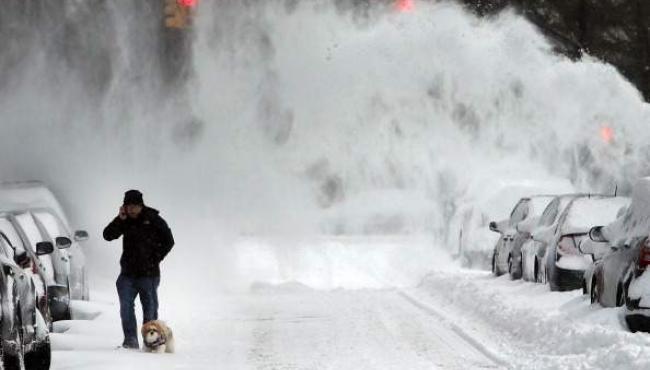A new study in Nature says #Climate Change may force the polar vortex to dip down more often, triggering bone-chilling winters in Europe and North America. Many of the claims of an overheated Earth dissipate during winter as temperatures plummet and heating bills rise. Yet the authors write that as the Arctic warms and more sea ice melts, additional ocean water is exposed, absorbing the sun’s warmth.
The excess warmth then gets released over a longer time period, interrupting the polar vortex and pushing it down into lower latitudes. Sea ice, however, reflects the sun’s rays back into space, causing temperatures to plummet during thewinter. That’s what happened in early 2014 and 2015 when Arctic air bullied its way toward more temperate regions.
In 1979, global cooling since the 1940’s was indisputable.
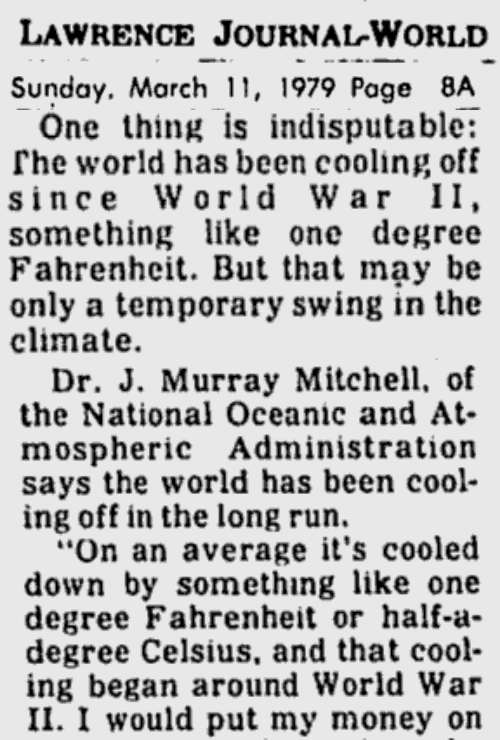
Lawrence Journal-World – Google News Archive Search
By 1989, NOAA extended the cooling trend back from 1921 to 1979, and said most warming occurred before 1919.
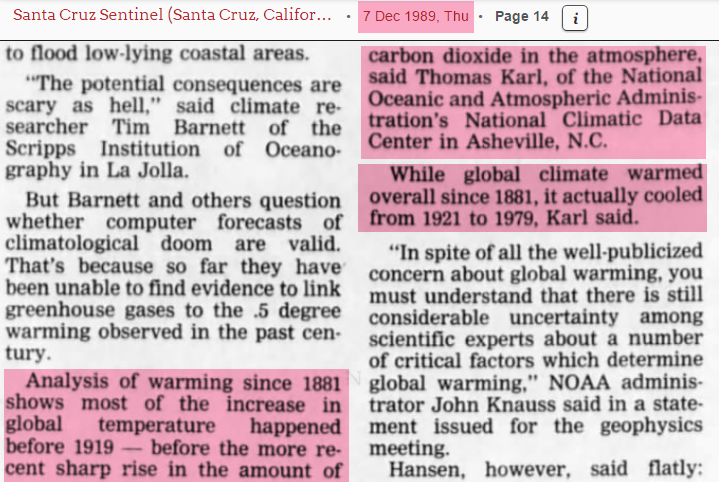
7 Dec 1989, Page 14
A year later, Phil Jones reversed NOAA’s cooling trend, and turned it into half a degree warming from 1890 to 1990.
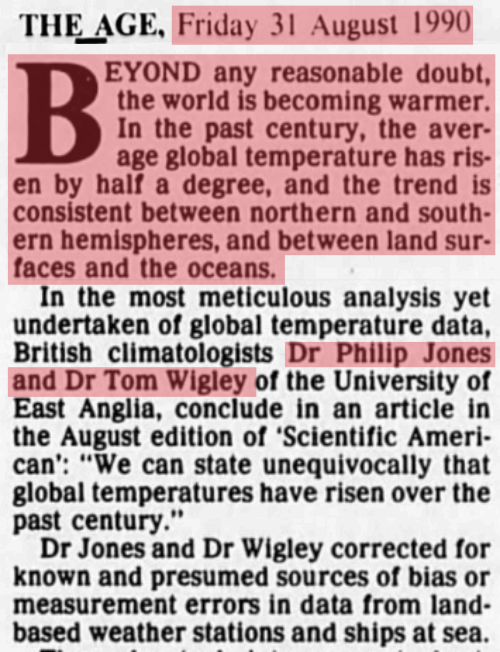
31 Aug 1990, Page 11 – The Age at Newspapers.com
And now Gavin Schmidt at NASA has doubled Phil Jones 1890-1990 trend, and turned it into 1.0C warming.
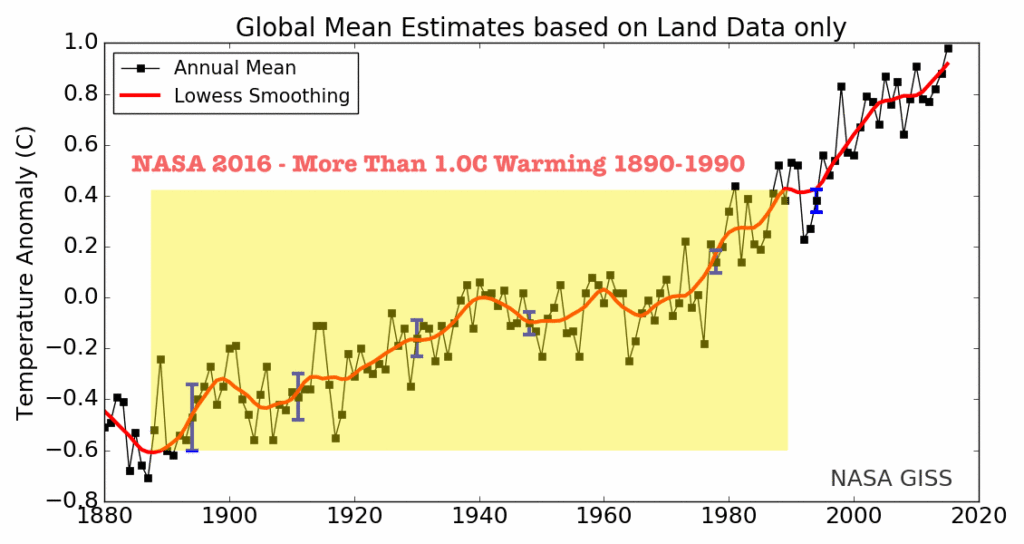
graph.png (1130×600)
…
Watch: Exclusive clip of ‘Climate Hustle’ on Fox News – Steve Doocy & Marc Morano reveal mystery climate mascot animal

Fox News on Sunday April 24, 2016 invited Marc Morano to explain how the armadillo was both a mascot for 1970s global cooling fears and a mascot for current global warming fears.
“This is significant,” Morano said after revealing a stuffed armadillo in a cage. “The armadillo was the only animal that was used a mascot for global cooling in the 1970s… It’s now being used as a mascot for global warming. They’re claiming the armadillo is migrating north to get out of the heat.”
“With global warming, they have a learning curve,” he explained. “They’re trying to go much further in the future [with their doomsday predictions] when the people making the predictions will be dead.”
#
[It’s Here! CLIMATE HUSTLE DVDs and Blu-rays are NOW AVAILABLE! Order yours today!
Groundbreaking film that packed theaters across America on May 2nd called “brutal and extremely funny” by National Review, “tremendous” by Cal Thomas, and World Net Daily says it “could be the most important movie of the year.” (Order now: www.ClimateHustle.com)
…
“Whether polar bears are 350,000 years old or 6 million years old, unless we take action to curb greenhouse gas emissions, they face a future where the climate will continue to warm. And this warming will be unlike anything polar bears have survived before.” — Polar Bears International

Image: NoTricksZone
During the Pliocene, or from about 3 to 5 million years ago, subarctic regions of the Northern Hemisphere (Norway, Iceland, Canada) were up to 10°C warmer than they are now, and the Arctic region itself was as much as 19°C warmer than now, with sea-ice-free summers and no permafrost. All this warmth occurred while CO2 concentrations were well below today’s levels. Polar bears somehow managed to survive in these balmy Arctic and subarctic climates.
Robinson, 2010
“Pollen from three subarctic sites in the Norwegian Sea, northern Iceland and Labrador Sea indicate that mid-Pliocene January temperatures in Norway, Iceland and southeastern Canada were 4 to 10°C warmer than today (Willard 1994). … Evidence of both mixed deciduous/coniferous and coniferous forests placesmean July temperatures 10°C warmer than today [in Arctic Canada] (Vincent 1990). In addition, northwestern Alaska air and sea temperatures during peak Pliocene interglacials were considerably warmer than present, by 7 to 8°C, with no permafrost, and absent or severely limited sea ice (Carter et al. 1986; Kaufman and Brigham-Grette 1993).”
From the press release, Robinson states that Arctic summer sea surface temperatures were about 10-18°C (50 – 64°F) on average 4 million years ago, compared to 0°C (and lower) during summers today.
“The U.S. Geological Survey found that summer sea-surface temperatures in the Arctic were between 10 to 18°C (50 to 64°F) during the mid-Pliocene, while current temperatures are around or below 0°C (32°F).”
Ballantyne et al., 2010
“The consensus among these proxies suggests that Arctic temperatures were ∼19 °C warmer during the Pliocene than at present, while atmospheric CO2 concentrations were ∼390 ppmv.”
Cronin and Cronin, 2015
“Pliocene Arctic Ocean summer SSTs were appreciably warmer than modern and seasonally sea-ice free conditions existed in some regions. … At Lake El’gygytgyn (Lake ‘‘E’’) in Siberia summer temperatures were 8°C warmer than modern and at Ellesmere Island, Canada, summer and MAT [mean annual temperatures] were 11.8°C and 18.3°C higher than today.”
“[A] seasonally ice-free marginal and central Arctic Ocean was common … regionally during the early Holocene [6,000 to 10,000
…

